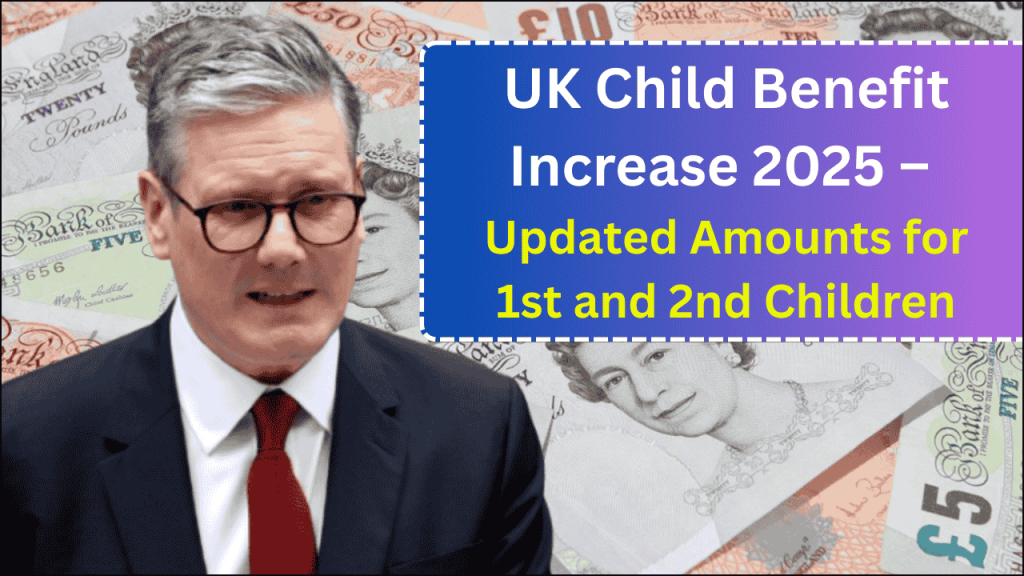
The UK government has officially implemented an increase to Child Benefit rates as of May 2025, providing much-needed additional support to millions of families across the country. This adjustment comes in response to rising living costs and represents the government’s ongoing commitment to supporting parents and guardians raising children in increasingly challenging economic circumstances.
The new rates, which apply to all eligible households, offer a modest but meaningful boost to family finances at a time when many are feeling the squeeze from inflation and higher everyday expenses. This article provides a comprehensive overview of the updated Child Benefit system, including the new payment amounts, eligibility criteria, and practical guidance for claimants.
New Child Benefit Payment Rates for 2025
The 2025 Child Benefit increase follows the government’s spring budget review and reflects adjustments designed to help offset rising costs for families. The new weekly payment rates represent a noticeable improvement compared to the previous year’s figures:
| Child Category | Weekly Rate (May 2025) | Previous Weekly Rate (2024) | Increase | Annual Value (2025) | Annual Increase |
|---|---|---|---|---|---|
| First Child | £25.90 | £24.00 | £1.90 | £1,346.80 | £98.80 |
| Each Additional Child | £17.25 | £15.90 | £1.35 | £897.00 | £70.20 |
This increase translates to approximately 7.9% for the first child and 8.5% for additional children, outpacing the current inflation rate of 2.3% (as of April 2025). For a family with two children, this means an additional annual payment of £169 compared to 2024 rates – a welcome boost to household budgets.
“These updated rates reflect our commitment to supporting families as they navigate the ongoing cost of living challenges,” stated the Chancellor in the recent budget announcement. “While modest in isolation, these increases form part of our broader strategy to provide meaningful financial assistance to those raising the next generation.”
For the most up-to-date information on Child Benefit rates and payment dates, visit the official government page: https://www.gov.uk/child-benefit-rates
Eligibility Criteria for Child Benefit in 2025
The fundamental eligibility requirements for Child Benefit remain largely unchanged in 2025, maintaining the program’s wide accessibility for families:
| Eligibility Factor | Details |
|---|---|
| Child Age Requirement | Under 16, or under 20 if in approved education or training |
| Relationship | Person claiming must be responsible for the child |
| Residency | Claimant must live in the UK |
| Immigration Status | Claimant must have right to reside and be habitually resident |
| Number of Children | No limit on the number of eligible children that can be claimed for |
It’s important to note that while there is no limit to how many children can be claimed for under Child Benefit, other benefits may still be subject to the two-child limit policy introduced in 2017. This has not been amended in the 2025 updates.
To check your specific eligibility circumstances, use the Child Benefit eligibility checker tool: https://www.gov.uk/child-benefit/eligibility
The High-Income Child Benefit Charge (HICBC)
Despite calls from various advocacy groups, the High-Income Child Benefit Charge thresholds remain unchanged in 2025. This means that families where one parent earns over £50,000 annually will continue to face a gradual reduction in their effective benefit:
| Individual Income (Annual) | Effect on Child Benefit |
|---|---|
| Up to £50,000 | No reduction – full payment received |
| £50,001 to £60,000 | Partial reduction through tax charge (1% of benefit for every £100 over threshold) |
| Over £60,000 | Full reduction – 100% of benefit reclaimed through tax |
This charge is applied through the tax system rather than by reducing the actual payment, which means affected families receive the full Child Benefit but then repay some or all of it through their tax return. This approach preserves National Insurance credits for non-working parents, which are important for future pension entitlements.
Some critics argue that the unchanged HICBC thresholds represent a form of “fiscal drag” as inflation pushes more families into this category without any corresponding increase in real earnings. However, no adjustments to these thresholds were included in the 2025 policy updates.
For guidance on the High-Income Child Benefit Charge and to calculate potential tax liability, visit: https://www.gov.uk/child-benefit-tax-charge/overview
How to Claim Child Benefit in 2025
For new parents or those who have recently become responsible for a child, the claiming process remains streamlined in 2025:
| Application Method | Details | Timeline |
|---|---|---|
| Online Application | Available through Government Gateway account | Quickest processing time |
| Paper Form CH2 | Available to download or order by phone | Takes longer to process |
| Backdating | Claims can be backdated up to 3 months | Must apply within this window |
New parents are strongly encouraged to apply as soon as possible after their child’s birth or arrival, as Child Benefit can only be backdated for up to three months. This means delaying an application beyond this period results in permanently lost payments.
The application requires the child’s birth certificate and the personal details of all parents/guardians involved. For children born in the UK, the Registrar may offer a service to start the Child Benefit claim when registering the birth.
To begin a new Child Benefit claim online or download the claim form, visit: https://www.gov.uk/child-benefit/how-to-claim
Payment Schedule and Practical Considerations
Understanding the payment schedule helps families effectively budget and plan their finances:
| Payment Aspect | Standard Arrangement | Alternative Options |
|---|---|---|
| Payment Frequency | Every 4 weeks | Weekly payments available for single parents or those on certain benefits |
| Payment Method | Direct bank transfer | No alternative methods available |
| Payment Day | Dependent on National Insurance number | Fixed schedule based on last two digits of NI number |
| Holiday/Weekend Adjustments | Payments due on bank holidays/weekends are paid early | Usually the preceding working day |
It’s worth noting that Child Benefit payments can continue during temporary absences from the UK (up to 12 weeks for most circumstances, or up to 16 weeks for medical treatment, death, or if a family member is in the armed forces). However, permanent moves abroad will generally end eligibility.
For specific questions about payment schedules and to check upcoming payment dates, see: https://www.gov.uk/child-benefit/payment-dates
Reporting Changes and Maintaining Your Claim
Keeping your Child Benefit claim updated is essential to avoid complications or potential overpayments that would need to be returned:
| Change to Report | Timeframe | Method |
|---|---|---|
| Child starting/leaving approved education | Immediately | Online or phone |
| Change of address | Within 4 weeks | Online or phone |
| Change of bank details | Before next payment | Online or phone |
| Child leaving the household | Immediately | Online or phone |
| Death of a child | Immediately | Phone only |
| Moving abroad | Before departure | Online or phone |
Failing to report relevant changes could result in overpayments that must be repaid or, in some cases, penalties for incorrect claims. The system is designed to be flexible for legitimate changes in circumstances, but requires prompt notification.
Changes can be reported through your Child Benefit online account or by contacting the Child Benefit Office directly: https://www.gov.uk/report-changes-child-benefit
Child Benefit and National Insurance Credits
One often overlooked aspect of Child Benefit is its connection to National Insurance credits, which are crucial for state pension entitlement:
| Situation | National Insurance Impact |
|---|---|
| Claiming Child Benefit for a child under 12 | Automatically receive Class 3 NI credits if not working or earning below NI threshold |
| Opted out due to HICBC | Can claim NI credits without receiving payments by completing CH2 form and selecting this option |
| Not claiming at all | Missing out on potential NI credits that count toward state pension |
This connection to National Insurance makes Child Benefit valuable even for higher-earning families who might not benefit financially from the actual payments due to the HICBC. In these cases, claiming but opting out of payments ensures NI credits are still received.
For information on protecting your National Insurance record while claiming Child Benefit, visit: https://www.gov.uk/national-insurance-credits/eligibility
Regional Variations and Universal Application
Unlike some benefits that vary by local authority, Child Benefit is administered nationally with consistent rates and rules across all UK regions:
| Region | Child Benefit Administration | Rates |
|---|---|---|
| England | HMRC | Standard UK rates |
| Scotland | HMRC | Standard UK rates |
| Wales | HMRC | Standard UK rates |
| Northern Ireland | HMRC | Standard UK rates |
This uniformity provides equity across different parts of the UK and simplifies the system for families who move between regions. However, it’s worth noting that Scotland has introduced additional support through the Scottish Child Payment, which exists alongside the UK-wide Child Benefit.
Budgetary Impact and Future Outlook
The 2025 Child Benefit increase represents a significant budgetary commitment from the government:
| Aspect | Financial Impact |
|---|---|
| Total Annual Expenditure | Approximately £14.2 billion |
| Number of Children Covered | Around 12.8 million |
| Number of Families Receiving Payments | Approximately 7.3 million |
| Average Annual Increase per Family (2025) | £152 |
Looking ahead, the government has indicated that Child Benefit rates will continue to be reviewed annually, with adjustments typically announced during budget statements. While no specific commitments have been made beyond the current increases, the ongoing cost of living challenges suggest that support for families will remain a priority in future fiscal planning.
Conclusion: Making the Most of the 2025 Increases
The 2025 Child Benefit increases offer a modest but welcome boost to family finances during challenging economic times. While the additional £1.90 per week for the first child and £1.35 for subsequent children may seem small in isolation, these amounts accumulate to meaningful sums over the course of a year.
For families navigating the complexities of childcare costs, rising utility bills, and general inflation, this additional support – combined with other available benefits and tax credits – can make a significant difference to household budgets. Understanding the full range of support available, including how Child Benefit interacts with other elements of the welfare system, allows families to maximize their financial resilience.
Whether you’re a new parent applying for the first time or an existing claimant adjusting to the new rates, staying informed about the Child Benefit system helps ensure you receive the full support to which your family is entitled.
For comprehensive guidance on all aspects of Child Benefit and to access the full range of supporting services, visit the main Child Benefit hub page: https://www.gov.uk/child-benefit
FAQs
What is the new weekly Child Benefit rate for the first child in May 2025? £25.90 per week for the first child, an increase of £1.90 from the previous rate.
Do high earners still need to pay back Child Benefit through tax? Yes, individuals earning over £50,000 annually must repay some or all Child Benefit through the High-Income Child Benefit Charge, with the threshold unchanged in 2025.
Can I claim Child Benefit for my 18-year-old who is still studying? Yes, you can claim for children under 20 who are in approved education or training.

Isabell Johnson is a passionate writer known for captivating stories that blend imagination and reality. Inspired by travel, history, and everyday moments, She crafts narratives that resonate deeply with readers.




